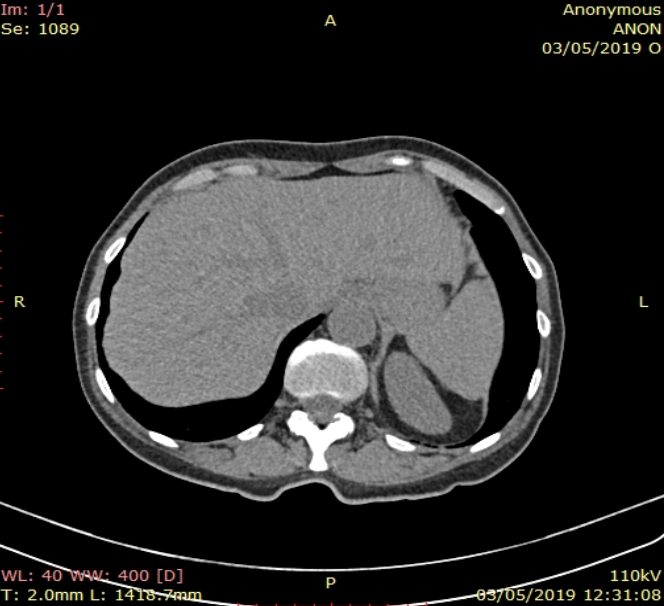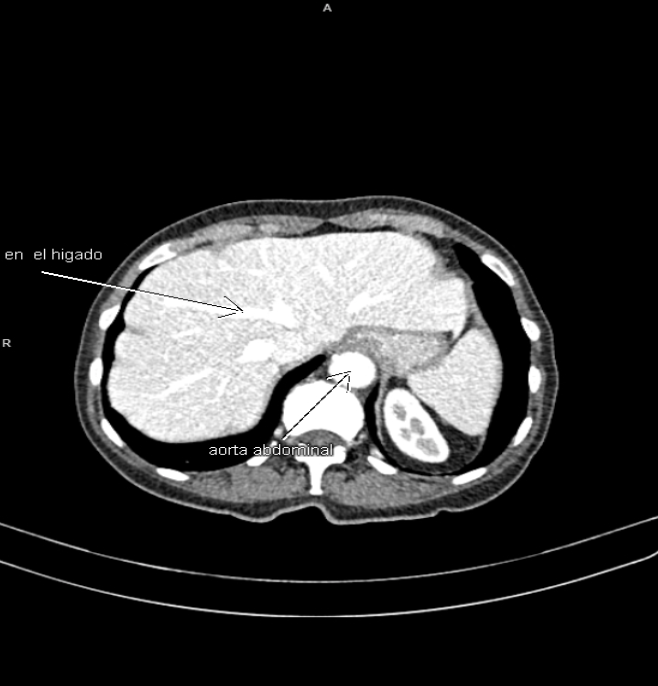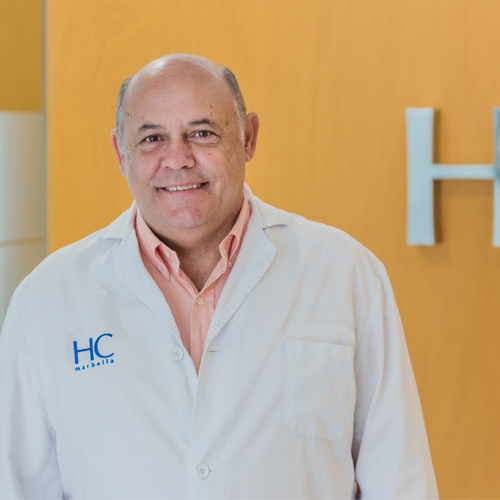Angiography is a barely-invasive medical examination which helps doctors to diagnose and treat illnesses. In most cases, an injection of contrast material is needed to produce images of the main blood vessels of the whole body.
It is the use of CT (computarised tomography) to visualise the large and medium-sized blood vessels in almost any part of the human body, thanks to the use of intravenous contrast. (Iodine contrast through a vein in the arm).
Angiography is a barely-invasive medical examination which helps doctors to diagnose and treat illnesses. In most cases, an injection of contrast material is needed to produce images of the main blood vessels of the whole body.
Look at image 1 (axial section of the abdomen). Can you identify the aorta or the veins of the liver in this study without contrasts?

Image 1 ( axial section of the abdomen)
Now look at image 2 (below) of the axial section of the abdomen with contrast (the aorta and the veins of the liver are marked).

Image 2 (axial section of the abdomen with contrast)
In the first image without contrast we can see the aorta as a dark circle and we cannot say anything about its content. In the second image we see the aorta with contrast inside. We can speak of its content and be sure about its morphology.
Fundamentally arterial or venous.
Depending on the interval between the administration of the contrast and the study being carried out, we can see the arteries very clearly (the CT is carried out a few seconds after the contrast has been administered, e.g. between 15 and 30 seconds), veins (e.g. in the abdomen in 60 to 70 seconds). Even if we want to be sure about the opacification of a specific arteryI (e.g. the pulmonary artery, to eliminate pulmonary embolism) we can be sure with special techniques of the bolus tracking type.
• Haemorrhages (“the contrast comes out of the blood vessels“).
• Aneurysm, which is when the vessels dilate because of the weakness of the wall (nearby structures can grow or be compressed, burst with sometimes massive bleeding, coming from the pumps).
• Stenosis (narrowing) of the vessels (e.g.coronaries in patients at risk of heart attack / angina, but practically of any blood vessel in the body).
• Thrombosis of the vessels (contrast is missing inside the vessel occupied by the thrombus).
• Understand the vascularisation of the organ for later surgery.
• See malformations in the vessels, relation of the vessels to tumours …etc.
And practically any problem affecting the arteries and veins of the body.
The fundamental contraindications are renal insufficiency and allergy to the contrast, and it should be limited as much as possible in pregnant women and young patients.
On the other hand, it is a test that uses ionised radiation, so when it is carried out, a clear indication is needed in order not to expose patients unnecessarily to radiation.
Yes: almost every day. Brief duration and much information.
Yes. Doppler ecography can be used, magnetic resonance or invasive techniques
Since its introduction as a frequently practised technique it has substituted invasive diagnostic techniques that use catheters, arterial and venous punctures and that have more risk than CT angiotomography TC.
CT angiography is a diagnostic test. Evidently, it does not substitute for interventionist radiological and cardiological tests for treatment of the vessels.
It is possible that angiography eliminates the need to undergo surgery, and if the surgery is still necessary, it can be carried out with greater precision.
This test allows us more precise anatomical details than magnetic resonance (MR), particularly of the small blood vessels.
CT Angio is a useful way to detect arterial illnesses (such as the narrowing of the blood vessels in the heart) also venous ailments, and structural anomalies of the heart, before the symptoms appear, or when the symptoms are not clearly related to a disorder of the blood vessels, like a heart attack.
It causes less discomfort in the patient, since the contrast material is injected in a vein in the arm, instead of injecting it in a catheter inserted in an important artery or vein.
HC Marbella places the latest technological advances in diagnosis by imaging at the service of our patients.
HC Radiology opts for digital technology, in order to offer our patients all the advantages available: a lower amount of radiation in each test, greater quality of the images obtained and great speed in the process.
 Dr. Francisco Javier De Castro
Dr. Francisco Javier De Castro
Medical specialist in Radiology and Internal Medicine.
May 20, 2019
Read other news
Tel.: +34 952 908 628
+34 609 148 799
952908898 Oncology
951829978 Diagnosis by imaging
951829947 Gynecology
952908897 Fertility
951829947 Physiotherapy